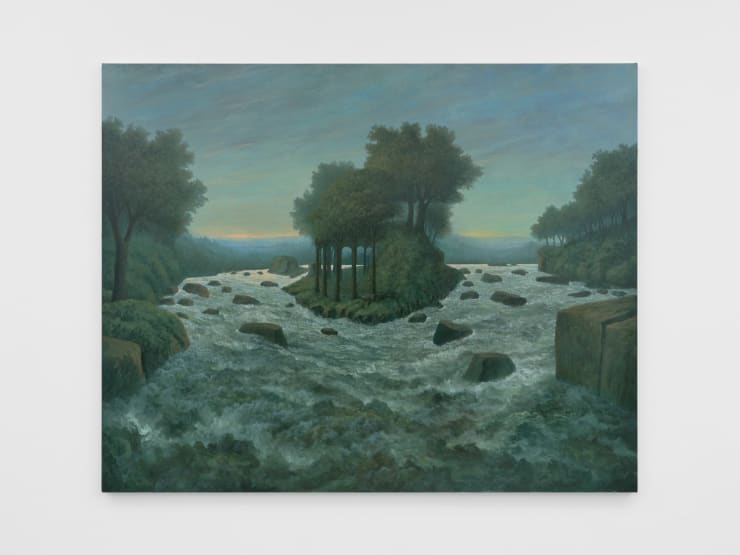Alchemical Landscape: Sholto Blissett | Tom Bull
Cob Gallery is proud to launch its 2024 programme with its inaugural ‘dual’ exhibition, presented across two exhibition spaces. In Gallery One, American landscape painter James Morse will present his UK debut The Hands That Comb The Hills. Gallery Two will host Alchemical Landscape, a complementary selection of work by British artists Tom Bull and Sholto Blissett.
Beginning in 2024, Cob’s dual exhibition series presents solo shows by established international artists alongside exhibitions of work by emergent UK-based practitioners – an ongoing focus of the gallery’s programming. Cohering around shared atmospherics or thematic concerns, these exhibitions aim to spark new dialogues; they are conceived in terms of conjunction and counterpoint rather as paired or grouped presentations.
Morse, Bull and Blissett share an understanding of landscape and the ‘natural’ world as something rich with unresolved questions about culture, identity and meaning: as not only a place, but an idea that is both heavy with prewritten significance and constantly re-imagined anew. Displayed alongside one another, the artists’ preoccupations with these ideas crystallise as a distinctively contemporary vision of landscape for the present moment.
Alchemical Landscape | Sholto Blissett and Tom Bull
British artists Sholto Blissett and Tom Bull present ‘Alchemical Landscape’, a group of two- and three-dimensional works reconnoitring our relationship with an environment that sometimes seems anything but ‘natural’. The title of this part of the exhibition references an eponymous multi-platform research project at Cambridge University, an initiative which interrogated the British landscape as a frequently uncanny or unnerving space often characterised by a bizarre layering of mythic pasts, derelict presents, and uncertain futures. Bull and Blissett’s work takes up the atmospherics of this disjuncture, seeing landscape as an overdetermined site ‘haunted’ by its own cultural representations as well as the contemporary forces of capital and climate breakdown. Interested by folk traditions and an expansive, often paganistic notion of ‘Britishness’, their work invokes histories ranging from the dissolution of the monasteries through to 90s rave culture: from Tintern Abbey to Castlemorton Common, and beyond.
Commonalities can be drawn between the works of Blissett and Bull in their investigation of the British landscape’s complex historical and cultural pasts, as well as their questioning, among many other things, of notions surrounding the term ‘landscape of stewardship’. Their work revels in both the beauty found in the British countryside and its propensity as a site of anxiety. Meanwhile, their approaches to nature and the landscape interrogate the intersections of religion, sustainability and environmental ethics.
The presentation includes one large-scale painting by Blissett and four sculptural works by Bull. All four works by Bull are coated in bitumen, a material emblematic of the artist’s material exploration and defining the oiled black aesethetic of his sculptural practice. Often the employment of this material challenges the very forms his sculptures represent. Two new sculptural works, a six-seater bench and a wall-mounted chair, draw inspiration from furniture associated with the ‘Shakers’, a millenarian Christian sect founded in the mid-1700s. Closer inspection reveals that these works are partially constructed from discarded nitrous oxide canisters: a formal subversion that challenges the principles of Shaker design, which embraced simplicity, eschewing unnecessary embellishments and a commitment to sustainability and responsible resource management. If the Shakers’ ideas reflected a desire to coexist harmoniously with the Earth, then Bull’s disruptive approach shifts them into a potent symbol of toxic, man made industrial waste and humanity’s destructive tendencies.
This intentional subversion introduces an apocalyptic undertone, echoing the Shaker religious belief in an imminent end of the world. Nitrous oxide, identified as a greenhouse gas, contributes to ozone-damage and escalating global temperatures, serving as a poignant metaphor for the threats faced by the British countryside. In this way, Bull transforms motifs of the British landscape, infusing them with destabilising elements that appear to jeopardise its very existence.Furthermore, Bull subtly draws parallels between the damaging effects of nitrous oxide as a widely abused recreational substance, particularly among young people, and the fervent, ecstatic worship characteristic of of ‘Shaking Quaker’ ceremonies. This juxtaposition weaves a narrative that explores the clash between British cultural heritage, religious practices, and an almost paganistic hedonism – a central theme explored by the artist and driving force behind Bull’s conceptual concerns.
Similarly, Blissett’s painting offers subtle references that draw on the history of Christianity and our relationship to the natural world, nature-worship and land ownership. Blissett rigorously investigates the fictions which societies create tounderstand their place in nature. With this, his compositions often centre around imagined architectural structures that blend both Classical and Gothic elements between functions: secular, religious, private, or communal. His painting ‘To See The Wood For The Trees’, for example, replaces this anchoring motif with a cluster of trees on an island – a sacred grove. The work reminds us of our island geography, and that our landscape is one informed and built upon by the influences of an array of cultures. Sacred groves play a crucial role in the mythological landscape and religious practices of various societies, including Celtic, Estonian, Baltic, Germanic, ancient Greek, Near Eastern, Roman, and Slavic polytheistic traditions. Additionally, in the Middle Ages, Christians constructed churches on the sites of sacred groves during the Northern Crusades. Here we are offered a vision of a landscape before human intervention and painting is fraught with a tension of a landscape on the brink of transformation, at the hands of humanity.
In Blissett’s practice, the idea of ‘landscape’ does not only describe a motif or genre; it also refers to a historically constructed concept to be dissected, and a visual tool through which to reflect on the relationship between humankind and nature. His work, at first glance imbued with a serene simplicity, stands at the crossroads between his love for landscape painting and his university training in geography. These various lenses through which Blissett contemplates landscape give depth to his approach. Informed by both observation and research and executed in a simultaneously naturalistic, fantastic, and resolutely painterly way, his imaginary, uninhabited biomes investigate how societies perceive, construct, and mythologise the natural world.
b. 1996, Salisbury, UK.
Lives and works in London.
Sholto Blissett read Geography at Durham University before studying for an MA in painting at the Royal College of Art, London. Blissett is known for his fictional landscape paintings depicting architectural follies set in rugged landscapes.
At the centre of Blissett's work is a preoccupation with humanity's frequent desire to distinguish itself from the rest of nature. Dualisms such as humans and nature, culture and wilderness, and history and biology are challenged in his work. No people are portrayed in Blissett's work, instead buildings or suggestions of buildings mark their presence. Classical follies coalesce with trees and rocks, or are formed of them entirely, suggesting a blurring of the assumed boundaries between humans and nature. Inspired by the view that humans cannot escape nature and that we never exist beyond its bounds, Blissett paints uncanny worlds where humans are neither free in a state of Arcadian bliss, nor exist in opposition to nature, but are simply and undeniably connected to it.
Recent solo exhibitions include Arboreal, Peres Projects, Milan, Italy (2023); Rubicon, Alexander Berggruen, New York, USA (2023); Ship of Fools, Hannah Barry Gallery, London, UK (2022). Recent group exhibitions include Alchemical Landscape, Cob Gallery, London, UK (2024); New Now: Part One, Guts Gallery, London, UK (2023); Fantastic Landscapes, Double Q Gallery, Hong Kong, China (2023); Manscaping, The Hole, New York, USA (2022); Utopia, Peres Projects, Berlin, Germany (2021); Tree and Leaf, Hannah Barry Gallery, London, UK (2021); Tomorrow: London, White Cube, London, UK (2020); London Grads Now, Saatchi Gallery, London, UK (2020); CIRCA 2020, Piccadilly Circus, London, UK (2020).
Tom Bull
b. 1995, Northamptonshire, UK.
Lives and works in London.
Tom Bull makes sculptures and video installations in an absurd attempt to capture the lived experience within these dark, strange and untrustworthy times. Through a landscape of folk, the rural, modernity and rituals, he investigates the tension and slippage between fiction and representation, violence and sensitivity, truth and mythology. With a wide range of tools and materials borrowed from architecture, model making, carpentry, aspirational design, preservation, farming and forestry, Tom Bull employs a sculptural practice that confronts and manipulates traditions, time periods, lore and genre. His most recent work interrogates “country life” by challenging personal and collective issues around land, loss, community, wealth, access, labour and violence.
Recent solo & duo exhibitions include Des Bains, London, UK (forthcoming 2024); Alchemical Landscape, Cob Gallery, London, UK (2024); Under Cover of Darkness, E-Werk, Freiburg, Germany (2023); Shallow Haunts, Kupfer, London, UK (2023). Recent group exhibitions include Small Hours, Alice Black, London, UK (2023); La Caverna una Casa, General Expenses, Mexico City, Mexico (2023); New Contemporaries, South London Gallery, London, UK (2022); Visions in the Nunnery (Selected by Patrick Goddard), Nunnery Gallery, London, UK (2022); Reconstruct/Deconstruct, OHSH Projects, London, UK (2022).
Featured Press
Issue 32: Tom Bull, Floorr Magazine, 2024
-
 Tom BullHardcore Cottagecore III, 2023Bitumen, cardboard, wood, expanding foam, PVC, varnish205 x 60 x 105 cm
Tom BullHardcore Cottagecore III, 2023Bitumen, cardboard, wood, expanding foam, PVC, varnish205 x 60 x 105 cm
80 3/4 x 23 5/8 x 41 3/8 in -
 Sholto BlissettTo See The Wood For The Trees, 2024Oil and acrylic on canvas160 x 200 cm
Sholto BlissettTo See The Wood For The Trees, 2024Oil and acrylic on canvas160 x 200 cm
63 x 78 3/4 in -
 Tom BullI haven’t fucked much with the past but I’ve fucked plenty with the future, 2024Bitumen, NOS canisters, wood, metal inserts, expanding foam, cable ties, varnish97 x 244 x 44 cm
Tom BullI haven’t fucked much with the past but I’ve fucked plenty with the future, 2024Bitumen, NOS canisters, wood, metal inserts, expanding foam, cable ties, varnish97 x 244 x 44 cm
38 1/4 x 96 x 17 3/8 in







